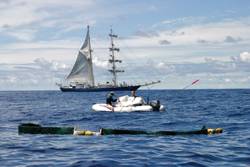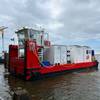Now in its fourth year, Project Kaisei has come to rely upon satellite communications for effective communication with colleagues ashore as well as its global support base. Mary Crowley talks about how the project’s requirements for communications are continuously evolving.
In the digital age it is easy to take for granted the benefits that reliable connectivity provides. In the maritime industry alone, always-on communications are supporting a wealth of applications to improve operational efficiency and crew welfare. But even today, the availability of modern communications capabilities is not guaranteed in some remote locations, which is why North Pacific Gyre cleaning operation ‘Project Kaisei’ was pleased to collaborate with Marlink and Sea Tel for its satellite communications services.
“Being able to communicate with our teams ashore during our expedition is vital to the success of the mission,” said Mary Crowley Director of Ocean Voyages Institute, and Co-Founder of Project Kaisei. “We depend on real-time updates from oceanographers and weather experts to help us locate areas of the greatest accumulations of plastic trash. Continued support from Marlink and Sea Tel is instrumental in helping to achieve our duel missions of education related to the global problem and to stop the flow of debris into the ocean to begin actual clean-up expeditions.”
Debris Collection
Set-up by Ocean Voyages Institute of California in 2008, a California 501(c)3 non-profit organization, Project Kaisei is the ‘Ocean Clean-up initiative’ of the Institute, focused on increasing awareness of the scale of marine debris, its impact on the environment and the solutions for both prevention and clean-up. The project aims to prevent further accumulation of marine debris in the ocean and apply new technologies to begin removing this waste.
Project Kaisei’s research findings have identified that debris falls into four major categories.
• One: Ghost nets/derelict fishing gear,
• Two: Floating consumer debris, ranging from car fenders to large plastic storage bins, plastic bottles and containers of all shapes and sizes,
• Three: Smaller plastic debris, ranging from tooth brushes to children's toys to broken down pieces of plastic, and
• Four: Micro plastics.
According to the project team, the four debris categories each present different challenges for clean-up that require technologies to be created and modified to find the best devices for extracting these different categories of debris. Having the availability of the satellite communications link is fundamental to the continued development of this global initiative and gives clean-up operations the ability to communicate and modify clean-up technologies being tested while at sea.
“Having the ability to send reports, photos and film from the ship makes a significant difference to the effectiveness of our operations,” continues Crowley. “Satellite communications allows us to take advantage of a whole host of applications. We also use it to keep track of weather patterns which influence debris distribution as well as communicate through blogs and email to provide the latest news, photographs and videos to our supporters worldwide.”
Better connected
2011 marks the third Project Kaisei expedition that Marlink and Sea Tel will support with the donation of VSAT equipment and services. “2009 was the first expedition that Marlink and Sea Tel supported and our ability to send text, photos and video in real time, greatly enhanced exposure of the project, helping to raise awareness of our cause,” said Crowley.
“During this voyage we were able to take part in several live radio interviews while sailing in the middle of the Pacific Ocean through our satellite communications system. The ability to communicate to audiences from our remote location and relay live what we were experiencing greatly contributed to the timeliness of the news, making it more relevant and dramatic. In today’s world with so much going on in terms of global news, the ability to communicate from the middle of the ocean while conducting studies of the debris issue is vital to gaining the media’s attention and support.”
Crowley continues: “Our vessel tracker application also relied heavily upon our satellite communications system and allowed team members to organise videos, blogs and photographs of daily events as well as Geo-locate our expedition vessels.”
“Our requirement for satellite communications in 2010 grew in response to increased activity. A lot of our operations involved working with expert oceanographers who carry out computer modelling of debris distributions throughout the world's oceans. The connectivity was extremely important in keeping us in contact with them, so that we could demonstrate how marine debris was being distributed in the North Pacific Gyre and identify the areas of great accumulation of debris that clean-up is most needed.”
“During the 2010 expedition, we received an influx of messages and questions from individuals seeking updates about our findings in the North Pacific Gyre and it was clear that bandwidth quantity would have to increase to facilitate real-time responses, photo upload and live interviews.”
Future support
During the past three years, Ocean Voyages Institute’s Project Kaisei, has been successful in studying and documenting what is going on in the Gyre from a scientific perspective. By reviewing ocean current distribution it has accomplished an encompassing survey of clean-up possibilities. In addition, the organisation has built a world renowned group of naval architects, marine engineers and ocean experts that are act as a 'think tank' for designing marine debris collection equipment. The project is currently working on four types of equipment which it believes will enable the four major categories of debris to be addressed.
“In 2011 our emphasis is surveying coastal areas and coastal Gyres created by rivers, bays and our other watersheds which are also accumulating debris. There is a great deal of interest in seeing how much of the debris can be found closer to shore,” Crowley said.
While becoming the center for information regarding marine debris collection equipment and heralding the need for global clean-up efforts, Project Kaisei has also been approached by various governments for assistance with designing marine debris collection vessels. “We have been approached by various maritime companies who have told us they have the equipment to accomplish marine debris collections and are working on ways of obtaining corporate and government investment to conduct the clean-up expeditions on a larger scale to test the equipment.
“Ultimately, the assistance of additional funding will enable us to fulfil the potential of providing accurate information on the best and most efficient ways of clean-up. Our future expeditions will be concentrating on continuing science, documentation of the problem, education and research for major clean-up efforts. Obviously, the ability to communicate remains fundamental to our success,” Crowley said.
On the web: http://www.projectkaisei.org
(As published in the Februay 2012 edition of Maritme Reporter & Engineering News - www.marinelink.com)











